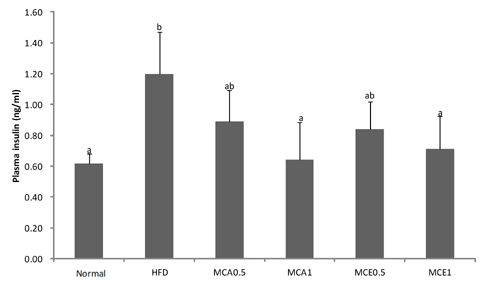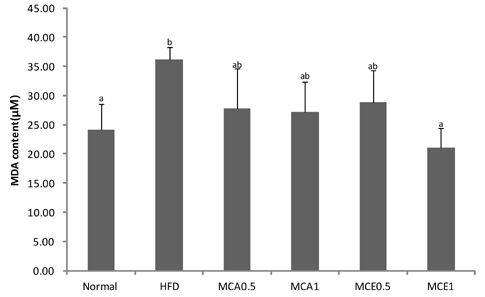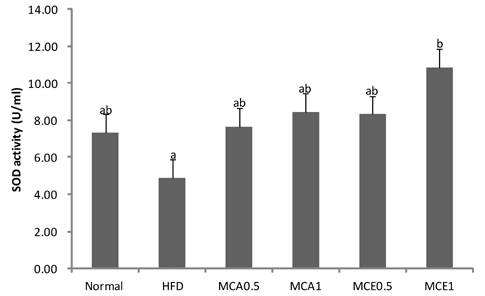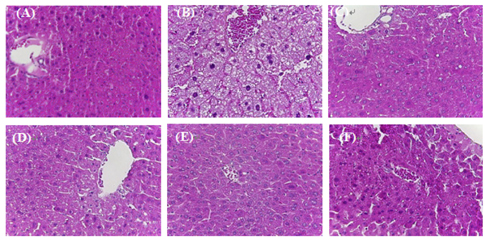Nutr Res Pract.
2015 Oct;9(5):489-495. 10.4162/nrp.2015.9.5.489.
The effects of Momordica charantia on obesity and lipid profiles of mice fed a high-fat diet
- Affiliations
-
- 1Department of Food Science and Nutrition, Pusan National University, Busandaehak-ro, 63beon-gil, Geumjeong-gu, Busan 609-735, Korea. hokryu@pusan.ac.kr
- KMID: 2313869
- DOI: http://doi.org/10.4162/nrp.2015.9.5.489
Abstract
- BACKGROUND/OBJECTIVES
The present study was conducted to investigate the effects of dried Momordica charantia aqueous extracts (MCA) and ethanol extracts (MCE) on obesity and lipid profiles in mice fed a high-fat diet.
MATERIALS/METHODS
Forty two ICR mice were randomly divided into six groups. The normal group was fed a basal diet, and other groups were fed a 45% high-fat diet (HFD) for 7 weeks. The normal and HFD groups were also orally administered distilled water each day for 7 weeks. The remaining groups received Momordica charantia extract (0.5 or 1.0 g/kg/day MCA, and 0.5 or 1.0 g/kg/day MCE). In order to measure the anti-obesity and lipid profile improvement effects, body and visceral tissue weight, lipid profiles, plasma insulin levels, hepatic malondialdehyde (MDA) levels and superoxide dismutase (SOD) activity were measured.
RESULTS
Both MCA and MCE significantly decreased body and visceral tissue weight relative to those of the HFD group (P < 0.05). Additionally high doses of MCE and MCA significantly reduced the plasmatic insulin levels compared to the HFD groups (P < 0.05) to concentrations comparable to those found in the normal group. MCA and MCE supplementation also significantly modulated the lipid profiles in plasma, liver, and feces compared to mice fed the HFD (P < 0.05). Furthermore MCA and MCE significantly increased hepatic SOD activity, and reduced MDA generation in the liver of the HFD mice (P < 0.05).
CONCLUSIONS
Results from the present study suggest that Momordica charantia extracts have anti-obesity effects and the ability to modulate lipid prolife of mice fed a HFD by suppressing body weight gain, visceral tissue weight, plasma and hepatic lipid concentrations, and lipid peroxidation along with increasing lipid metabolism.
Keyword
MeSH Terms
Figure
Reference
-
1. Haththotuwa RN, Wijeyaratne CN, Senarath U. Worldwide epidemic of obesity. In : Mahmood T, Arulkumaran S, editors. Obesity: A Ticking Time Bomb for Reproductive Health. London: Elsevier;2013. p. 4–10.2. Yoon KH, Lee JH, Kim JW, Cho JH, Choi YH, Ko SH, Zimmet P, Son HY. Epidemic obesity and type 2 diabetes in Asia. Lancet. 2006; 368:1681–1688.
Article3. Oh SW. Obesity and metabolic syndrome in Korea. Diabetes Metab J. 2011; 35:561–566.
Article4. Wu YF, Ma GS, Hu YH, Li YP, Li X, Cui ZH, Chen CM, Kong LZ. The current prevalence status of body overweight and obesity in China: data from the China National Nutrition and Health Survey. Zhonghua Yu Fang Yi Xue Za Zhi. 2005; 39:316–320.5. Grundy SM. Obesity, metabolic syndrome, and cardiovascular disease. J Clin Endocrinol Metab. 2004; 89:2595–2600.
Article6. Parikh NH, Parikh PK, Kothari C. Indigenous plant medicines for health care: treatment of Diabetes mellitus and hyperlipidemia. Chin J Nat Med. 2014; 12:335–344.
Article7. Liao CC, Su TC, Chien KL, Wang JK, Chiang CC, Lin CC, Lin RS, Lee YT, Sung FC. Elevated blood pressure, obesity, and hyperlipidemia. J Pediatr. 2009; 155:79–83. 83.e1
Article8. Halliwell B, Chirico S. Lipid peroxidation: its mechanism, measurement, and significance. Am J Clin Nutr. 1993; 57:715S–724S.
Article9. Abd El Sattar El Batran S, El-Gengaihi SE, El Shabrawy OA. Some toxicological studies of Momordica charantia L. on albino rats in normal and alloxan diabetic rats. J Ethnopharmacol. 2006; 108:236–242.
Article10. Ahmed I, Lakhani MS, Gillett M, John A, Raza H. Hypotriglyceridemic and hypocholesterolemic effects of anti-diabetic Momordica charantia (karela) fruit extract in streptozotocin-induced diabetic rats. Diabetes Res Clin Pract. 2001; 51:155–161.
Article11. Grover JK, Yadav SP. Pharmacological actions and potential uses of Momordica charantia: a review. J Ethnopharmacol. 2004; 93:123–132.
Article12. Chen Q, Chan LL, Li ET. Bitter melon (Momordica charantia) reduces adiposity, lowers serum insulin and normalizes glucose tolerance in rats fed a high fat diet. J Nutr. 2003; 133:1088–1093.
Article13. Park SH, Ko SK, Chung SH. Euonymus alatus prevents the hyperglycemia and hyperlipidemia induced by high-fat diet in ICR mice. J Ethnopharmacol. 2005; 102:326–335.
Article14. Xu SP, Mao XY, Cheng X, Chen B. Ameliorating effects of casein glycomacropeptide on obesity induced by high-fat diet in male Sprague-Dawley rats. Food Chem Toxicol. 2013; 56:1–7.
Article15. M'Kada H, Munteanu M, Perazzo H, Ngo Y, Ramanujam N, Imbert-Bismut F, Ratziu V, Bonnefont-Rousselot D, Souberbielle B, Schuppe-Koistinen I, Poynard T. DILI group of the SAFE-T consortium. What are the best reference values for a normal serum alanine transaminase activity (ALT)? Impact on the presumed prevalence of drug induced liver injury (DILI). Regul Toxicol Pharmacol. 2011; 60:290–295.16. Yagi K. Simple assay for the level of total lipid peroxides in serum or plasma. Methods Mol Biol. 1998; 108:101–106.
Article17. Armstrong D, Browne R. The analysis of free radicals, lipid peroxides, antioxidant enzymes and compounds related to oxidative stress as applied to the clinical chemistry laboratory. In : Armstrong D, editor. Free Radicals in Diagnostic Medicine: A Systems Approach to Laboratory Technology, Clinical Correlations, and Antioxidant Therapy. New York (NY): Plenum Press;1994. p. 43–58.18. Malmstrom BG, Andreasson LE, Reinhammar B. Copper-containing oxidases and superoxide dismutase. In : Boyer PD, editor. The Enzymes. New York (NY): Academic Press;1975. p. 533.19. Shih CC, Lin CH, Lin WL. Effects of Momordica charantia on insulin resistance and visceral obesity in mice on high-fat diet. Diabetes Res Clin Pract. 2008; 81:134–143.
Article20. Popovich DG, Li L, Zhang W. Bitter melon (Momordica charantia) triterpenoid extract reduces preadipocyte viability, lipid accumulation and adiponectin expression in 3T3-L1 cells. Food Chem Toxicol. 2010; 48:1619–1626.
Article21. Srivastava Y, Venkatakrishna-Bhatt H, Verma Y. Effect of Momordica charantia Linn. pomous aqueous extract on cataractogenesis in murrin alloxan diabetics. Pharmacol Res Commun. 1988; 20:201–209.
Article22. Akhtar MS, Athar MA, Yaqub M. Effect of Momordica charantia on blood glucose level of normal and alloxan-diabetic rabbits. Planta Med. 1981; 42:205–212.
Article23. Srivastava Y, Venkatakrishna-Bhatt H, Verma Y, Venkaiah K, Raval BH. Antidiabetic and adaptogenic properties of Momordica charantia extract: an experimental and clinical evaluation. Phytother Res. 1993; 7:285–289.
Article24. Ahmed I, Adeghate E, Sharma AK, Pallot DJ, Singh J. Effects of Momordica charantia fruit juice on islet morphology in the pancreas of the streptozotocin-diabetic rat. Diabetes Res Clin Pract. 1998; 40:145–151.
Article25. Leatherdale BA, Panesar RK, Singh G, Atkins TW, Bailey CJ, Bignell AH. Improvement in glucose tolerance due to Momordica charantia (karela). Br Med J (Clin Res Ed). 1981; 282:1823–1824.
Article26. Jayasooriya AP, Sakono M, Yukizaki C, Kawano M, Yamamoto K, Fukuda N. Effects of Momordica charantia powder on serum glucose levels and various lipid parameters in rats fed with cholesterol-free and cholesterol-enriched diets. J Ethnopharmacol. 2000; 72:331–336.
Article27. Wu SJ, Ng LT. Antioxidant and free radical scavenging activities of wild bitter melon (Momordica charantia Linn. var. abbreviata Ser.) in Taiwan. Lebenson Wiss Technol. 2008; 41:323–330.
Article
- Full Text Links
- Actions
-
Cited
- CITED
-
- Close
- Share
- Similar articles
-
- Anti-obesity effects of Rapha diet(R) preparation in mice fed a high-fat diet
- Effects of d-alpha-tocopherol supplements on lipid metabolism in a high-fat diet-fed animal model
- Effects of Calcium and Genistein on Body Fat and Lipid Metabolism in High Fat-induced Obese Mice
- Effects of Soyoligosaccharide on Lipid Metabolism in Rats Fed the High Fat or Low Fat Diet
- Effects of Genistein Supplementation on Fatty Liver and Lipid Metabolism in Rats Fed High Fat Diet





